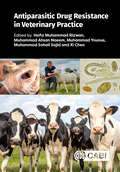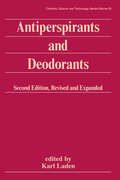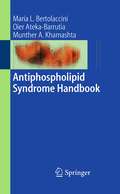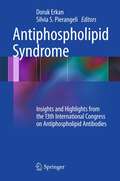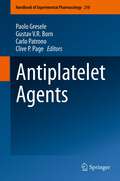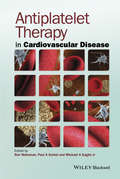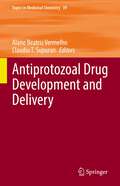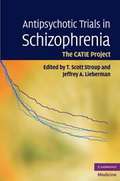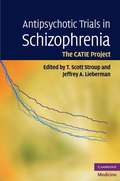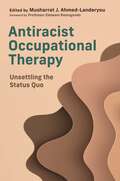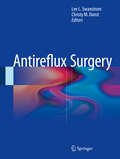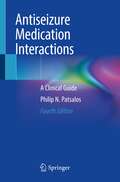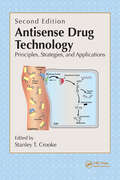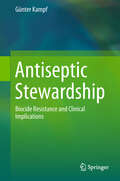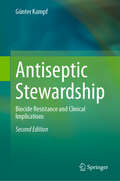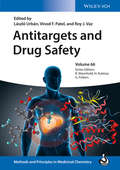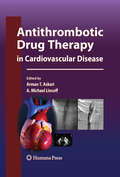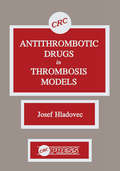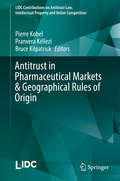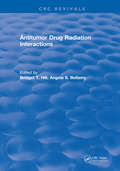- Table View
- List View
Antiparasitic Drug Resistance in Veterinary Practice
by Muhammad Usman Muhammad Imran Haider Abbas Dr Hafiz Muhammad Rizwan Dr Muhammad Sohail Sajid Dr Waqas Ahmad Muhammad Qasim Tooba Abbas Sumra Wajid Abbasi Zobia Afsheen Adeel Ahmad Zubaria Shahid Amin Farid Shokry Ataya Faiza Bano Ian Daniel Shamshad Fareed Zahid Fareed Muhammad Umar Farid Dalia Fouad Sadia Ghazanfar Adil Ijaz Ibadullah Jan Malcolm K. Jones Kashif Kamran Muhammad Abdullah Malik Zahid Manzoor Mahvish Maqbool Aiman Maqsood Manuela Marescotti Amir Munir Hizqeel Ahmed Muzaffar Shumaila Naz Nadia Nazish Fakhar Un Nisa HazratUllah Raheemi Haroon Rashid Muhammad Muneeb Rauf Mohsin Raza Aayesha Riaz Evelyn Saba Sadaf Faiz Abdullah Arif Saeed Muhammad Rizwan Saeed Rida Fatima Saeed Muhammad Nadeem Saleem Urfa Bin Tahir Rohit Tyagi Professor Muhammad Younus Muhammad Zeeshan Mian Mubashar Saleem M. Rajput Qaiser Akram Sibtain AhmadLack of clean water, inadequate sanitation, and insufficient infection prevention and control promote the spread of parasites. The discovery of antiparasitic drugs was considered a milestone in the veterinary and medical sciences, but their use has subsequently become limited due to the emergence of resistance. While plenty of attention has been given in human and animal health communities to the global threat of antimicrobial drug resistance, specific antiparasitic advice is less available. This book provides an in-depth view of the issue for parasitologists, pharmacologists and veterinary scientists. Specifically discussing antiparasitic drug resistance mechanisms and factors responsible for the problem, it covers: The physiological basis of parasitism; Resistance across protozoa, helminths, insects, mites and ticks; Molecular and phenotypic diagnostic methods; Practical strategies for mitigating resistance development. While it is clear that the veterinary field urgently requires the development of new antiparasitic drugs, of equal or even increased importance is the evaluation of alternative therapies and formulation of stringent policies to ensure appropriate drug use in veterinary practice. Highlighting the importance and development of resistance across different parasite groups, this book covers factors responsible for resistance development and advises strategies for effective stewardship and resistance mitigation.
Antiperspirants and Deodorants (Cosmetic Science and Technology)
by Karl LadenProvides a review of the most recent advances in the science and technology of controlling odour and wetness. This edition includes two new chapters on antiperspirant and deodorant formulations; two new chapters on relevant patent technologies of recent years; discussions on the chemistry of aluminium/zirconium antiperspirant salts; and a modernize
Antiphospholipid Antibody Syndrome: From Bench to Bedside (Rare Diseases of the Immune System #0)
by Pier Luigi MeroniThis book, part of the series Rare Diseases of the Immune System, offers comprehensive, up-to-date coverage of the pathophysiology and management of the antiphospholipid syndrome (APS). Immunologic and genetic aspects are discussed and the pathogenic mechanisms responsible for such phenomena as APS-mediated thrombosis and pregnancy loss/complications are explained. The main clinical manifestations, classification criteria and diagnostic tools are identified, and close attention is paid to the nature of the involvement of various organs or organ systems in APS. Specific chapters describe the treatment of the different symptoms, therapies of value in avoiding recurrences, and innovative treatment approaches. The authors are senior experts in the field who are aided by younger fellows, ensuring that the book is also educationally oriented. This handy volume will be a valuable tool for postgraduates in training and professionals wishing to extend their knowledge of this specific syndrome.
Antiphospholipid Syndrome Handbook
by Munther A Khamashta Oier Ateka-Barrutia Maria L. BertolacciniThis book discusses the major clinical features of the antiphospholipid syndrome. It provides a quick, practical and reader-friendly reference for the different problems that might be encountered in clinical practice. Treatment is a major concern in an area where evidence-based medicine is sparse and there are chapters dedicated to diagnosis from a laboratory point of view. Further chapters focus on subjects including pregnancy management, arterial thrombosis and prognosis. Due to the multi-disciplinary nature of this disease, the primary readership groups are general and internal medicine physicians and sub-specialties, including rheumatologists, hematologists, cardiovascular physicians, and obstetricians, among others.
Antiphospholipid Syndrome: Current Research Highlights and Clinical Insights
by Doruk Erkan Michael D. LockshinThis new edition is a comprehensive and updated resource on antiphospholipid syndrome (APS), which is an autoimmune disorder. In APS, the body recognizes certain normal components of blood and/or cell membranes as foreign substances and produces antibodies (antiphospholipid antibodies) against them. APS is associated with recurrent clotting events (thrombosis) including premature stroke, repeated miscarriages, phlebitis, venous thrombosis, and pulmonary thromboembolism. It is also associated with low platelet or blood elements that prevent bleeding. Recently, however, even more disease states have been linked with APS, including premature heart attack, various cardiac valvular abnormalities, skin lesions, kidney disease, abnormal involuntary movement/chorea, diseases that mimic multiple sclerosis, and vascular diseases of the eye that can lead to visual loss and blindness. The International Congress on Antiphospholipid Antibodies, held every 3 years, is the venue where representatives from different disciplines gather to discuss the recent advances in APS. The conference intends to cover basic aspects of APS, such as pathogenesis, origins, genetics, intracellular and molecular events, the role of infections, as well as traditional and non-traditional clinical manifestations associated with antiphospholipid antibodies. The 15th Congress took place in September 2016. A novel aspect of the Congress was that multiple teams, chaired by Scientific Planning Committee members, used evidence-based literature reviews and expert discussions to answer specific pre-defined APS-related questions. These teams included points of view from experts in rheumatology, hematology, cardiovascular medicine, obstetrics, neurology, and immunology. The Scientific Planning Committee members also chaired the congress sessions and supervised completion of the reports that are the bases of the chapters of this book. In addition, there are two chapters included specifically written for APS patients. Much like the previous volume, dedicated to the 13th International Congress on Antiphospholipid Antibodies (April 2010), this up-to-date and comprehensive work gathers invaluable insights from a multidisciplinary team of world-renowned experts and represents the authoritative resource on causes, symptoms, diagnosis, and treatment of APS.
Antiphospholipid Syndrome: Insights and Highlights from the 13th International Congress on Antiphospholipid Antibodies
by Doruk Erkan Silvia S. PierangeliThe International Congress on Antiphospholipid Antibodies is held every three years to discuss the recent advances and future directions in Antiphospholipid Syndrome (APS). This volume collects the scientific highlights and new findings about APS that were generated from the most recent 13th Congress, held in Galveston, Texas in 2010. Chapters were written by an internationally-distinguished group of scientists from the point-of-view of multiple specialty areas. Each chapter was written in a uniform and systematic basis to present the latest evidence-based research, including the basic science of APS, task force reports from the Congress on controversial aspects of APS, and future directions of APS research. This book will appeal to all clinicians involved in the treatment and management of APS patients, to residents in a variety of medical subspecialties, and to research scientists interested in a better understanding of this complex and evolving disease.
Antiplatelet Agents (Handbook of Experimental Pharmacology #210)
by Clive P. Page Gustav V. Born Paolo Gresele Carlo PatronoAntiplatelet therapy is the cornerstone of treatment of ischemic cardiovascular disease and over the last few years spectacular advancements in this field have been recorded. This is the first comprehensive handbook entirely dedicated to all the aspects of antiplatelet therapy. The book is divided into three main sections, pathophysiology, pharmacology and therapy, for a total of 23 chapters. A large group of leading experts from different European countries and from the USA, both from academia and industry, have contributed to the book. Besides a detailed overview on the pharmacology and clinical applications of all the currently used or of the novel antiplatelet agents, innovative approaches (e.g. intracellular signalling as an antiplatelet target, small RNAs as platelet therapeutics, etc.) or unconventional aspects (e.g. pharmacologic modulation of the inflammatory action of platelets are also treated. The book is oriented to both basic investigators and to clinicians involved with research on platelet inhibition or with the clinical use of antiplatelet therapies.
Antiplatelet Therapy in Cardiovascular Disease
by Michael A. Gaglia Jr. Paul A. Gurbel Ron WaksmanEdited by one of the world's leading interventional cardiologists and educators, this new book is created with an eye on giving the reader a solid, practical and clinically-focused understanding of this important class of drugs, from basic science to a clear-headed discussion of complex topics such as combination therapies, drug-drug interactions, and platelet resistance.This important new book:Begins with a concise but thorough discussion of platelet biology and pathophysiology so that readers understand how these therapies work and why they can also produce such a varied range of complications, from minor gastrointestinal upset, to potentially life-threatening conditions such as neutropenia, a critical shortage of white blood cells.Thoroughly covers platelet function testing, including new, novel techniques.Clarifies current best-practices regarding the use of antiplatelet agents in both chronic and acute cardiovascular diseaseReviews of all types of antiplatelet agents - from aspirin to recently approved drugs - including indications, clinical outcomes, and side effects/complicationsWritten by an international who's-who of experts in the field, Antiplatelet Therapy also includes an entire section covering the use of antiplatelet drugs in PCIs, including percutaneous valve repair, which makes this text particularly essential to Interventional Cardiologists.
Antiplatelet and Anticoagulation Therapy (Current Cardiovascular Therapy)
by Albert Ferro David A. GarciaThis title will be presented as highly practical information pn pharmaceutical antiplatelet and anticoagulation therapy, written in a quick-access, no-nonsense format. The emphasis will be on a just-the-facts clinical approach, heavy on tabular material, light on dense prose. The involvement of the ISCP will ensure that the best quality contributors will be involved and establish a consistent approach to each topic in the series. Each volume is designed to be between 120 and 250 pages containing practical illustrations and designed to improve understand and practical usage of cardiovascular drugs in specific clinical areas.
Antiprotozoal Drug Development and Delivery (Topics in Medicinal Chemistry #39)
by Claudiu T. Supuran Alane Beatriz VermelhoThis book reviews new promising drug targets for Neglected Tropical Diseases (NTDs), with a special focus on antiprotozoal drugs against trpyanosomatids Trypanosoma cruzi and Leishmania spp. The book offers a comprehensive overview of the most recent studied targets, and it outlines classical and new treatments and delivery strategies. Expert contributors describe new methods of analysis and bio-prospecting for new compounds, and provide a critical perspective of the translational process used in the research and development of new drug candidates. The book will appeal not only to researchers, students and professionals interested in drug development to protozoan diseases, but also to medicinal chemists in general.
Antipsychotic Trials in Schizophrenia
by T. Scott Stroup Jeffrey A. LiebermanAntipsychotic medications are a key treatment for schizophrenia, and sales of antipsychotic drugs approach $20 billion per year, with fierce marketing between the makers of the drugs.
Antipsychotic Trials in Schizophrenia
by T. Scott Stroup Jeffrey A. LiebermanAntipsychotic medications are a key treatment for schizophrenia and sales of antipsychotic drugs approach $20 billion per year, with fierce marketing between the makers of the drugs. The U.S. National Institute of Mental Health sponsored the Clinical Antipsychotic Trials of Intervention Effectiveness (CATIE) project to provide independent information about the comparative effectiveness of medications. CATIE was the largest, longest and most comprehensive study of schizophrenia to date. Conducted under rigorous double-blind conditions, Antipsychotic Trials in Schizophrenia presents the definitive archival results of this landmark study. The core of the book consists of chapters focused on specific outcomes that set the CATIE findings in a wider context. Also included are chapters on the design, statistical analyses and implications for researchers, clinicians and policy makers. Psychiatrists, psychiatric researchers, mental health policy makers and those working in pharmaceutical companies will all find this to be essential reading.
Antipsychotics
by Stephen M. Stahl Laurence MignonRelying upon the best-selling third edition of Stahl's Essential Psychopharmacology, Dr Stephen M. Stahl has revised chapters covering antipsychotics and mood stabilizers for this edition. More than one-third longer than the previous edition it is essential reading for professionals treating psychosis and students learning the mechanisms of drug reactions. It includes advances in neurobiology and recent clinical developments to explain the concepts underlying drug treatment of psychiatric disorders. The fully revised text is complemented by many new illustrations and enhanced to reflect new knowledge and topics covered in the previous edition. Intended as a primer text covering all aspects of treatment for psychosis and related conditions, this concise volume can nevertheless be read cover to cover by experts and novices alike. Accreditation and Credit Designation Statements The Neuroscience Education Institute is accredited by the Accreditation Council for Continuing Medical Education to provide continuing medical education for physicians. The Neuroscience Education Institute designates this educational activity for a maximum of 90. 0 AMA PRA Category 1 Credits(tm). Physicians should only claim credit commensurate with the extent of their participation in the activity. Sponsorship Information Sponsored by Neuroscience Education Institute Support This activity is supported solely by the sponsor. Neither the Neuroscience Education Institute nor Stephen M. Stahl, MD, PhD has received any funds or grants in support of this educational activity.
Antiracist Occupational Therapy: Unsettling the Status Quo
by VariousSocial justice, inclusion, and person-centredness are the cornerstones of occupational therapy but despite this, the experiences and inequities faced by Black and minoritised populations in health and social care often go unseen and unattended in occupational therapy practice.This timely book provides a compendium of global insights into the inequities faced by Black and minoritised groups in health and social care and considers how key changes in occupational therapy practice and education can redress disparities. Each contributor is active in the occupational therapy community and is incredibly well placed to provide guidance and practical suggestions on how to create sustainable, antiracist practice and disrupt the current status quo.Invaluable to occupational therapy professional bodies, academics, and students alike, this expansive collection of voices is essential reading for those looking to redress the imbalance of power caused by racism.
Antireflux Surgery
by Lee L. Swanstrom Christy M. DunstThis volume provides a comprehensive, state-of-the-art overview of the major issues specific to the field of antireflux surgery. It provides exceptional instructional detail regarding performance of antireflux surgery from leading esophageal surgeons around the world. This volume represents the only resource of its kind dedicated specifically to the issues unique to antireflux surgery. It is rich in detail and helpful illustrations that instruct surgeons in proper technique as well as presenting the reasoning behind various techniques. Written by experts in the field, Antireflux Surgery is of great value to practicing surgeons who perform gastrointestinal surgery, medical students, surgical residents, and fellows.
Antiseizure Medication Interactions: A Clinical Guide
by Philip N. PatsalosThis significantly revised fourth edition provides a practically orientated guide to interactions associated with antiseizure medications. It describes pharmacokinetic and pharmacodynamic antiseizure medication (ASM) interactions, including details of the magnitude and mechanism of interactions, and also of drug combinations that are not associated with interactions and therefore can be co-prescribed without undue concern. Presented in alphabetical order and by drug class, drug interactions that occur between ASMs and also between ASMs and non- ASMs are described in three sections: Drug interactions between ASMs; Drug interactions between ASMs and non- ASM Drugs: Interactions affecting ASMs; Drug interactions between ASMs and non ASM Drugs: Interactions affected by ASMs. The latest data on all drug interactions is presented. New agents discussed include cannabidiol, cenobamate, everolimus and fenfluramine,. Antiseizure Medication Interactions: A Clinical Guide, 4th Edition concisely presents the most recent developments and data available on the topic. Therefore, enabling physicians and allied health professionals to make more rational choices when ASM polytherapy regimens are required. It will be of interest to medical professionals in disciplines including neurology, psychiatry and pediatrics.
Antisense Drug Technology: Principles, Strategies, and Applications, Second Edition
by Stanley T. CrookeExtensively revised and updated, Antisense Drug Technology: Principles, Strategies, and Applications, Second Edition reflects the logarithmic progress made in the past four years of oligonucleotide-based therapies, and, in particular, antisense therapeutics and research. Interpreting lessons learned from the clinical trials of first generati
Antisepsis, Disinfection, and Sterilization: Types, Action, and Resistance (ASM Books)
by Gerald McDonnellAntisepsis, Disinfection, and Sterilization: Types, Action, and Resistance, by Gerald E. McDonnell, is a detailed and accessible presentation of the current methods of microbial control. Each major category, such as physical disinfection methods, is given a chapter, in which theory, spectrum of activity, advantages, disadvantages, and modes of action of the methods are thoroughly and clearly presented. Sufficient background on the life cycles and general anatomy of microorganisms is provided so that the reader who is new to microbiology will better appreciate how physical and chemical biocides work their magic on microbes. Other topics in the book include: Evaluating the efficacy of chemical antiseptics and disinfectants, and of physical methods of microbial control and sterilization. Understanding how to choose the proper biocidal product and process for specific applications. Classic physical and chemical disinfection methods, such as heat, cold, non-ionizing radiation, acids, oxidizing agents, and metals. Newer chemical disinfectants, including, isothiazolones, micro-and nano-particles, and bacteriophages as control agents. Antisepsis of skin and wounds and the biocides that can be used as antiseptics. Classic methods of physical sterilization, such as, moist heat and dry heat sterilization, ionizing radiation, and filtration, along with newer methods, including, the use of plasma or pulsed light. Chemical sterilization methods that use ethylene oxide, formaldehyde, or a variety of other oxidizing agents. A detailed look at the modes of action of biocides in controlling microbial growth and disrupting microbial physiology. Mechanisms that microorganisms use to resist the effects of biocides. The second edition of Antisepsis, Disinfection, and Sterilization: Types, Action, and Resistance is well suited as a textbook and is outstanding as a reference book for facilities managers and application engineers in manufacturing plants, hospitals, and food production facilities. It is also essential for public health officials, healthcare professionals, and infection control practitioners.
Antiseptic Stewardship: Biocide Resistance and Clinical Implications
by Günter KampfVarious antiseptic agents, such as chlorhexidine, are used for different applications, e.g. in healthcare, veterinary medicine, animal production and household products, including cosmetics. However, not all antiseptic agents provide significant health benefits, especially in some products used in human medicine (alcohol-based hand rubs, antimicrobial soaps). While some products (antimicrobial soaps, surface disinfectants, instrument disinfectants, wound antiseptics) may contain one or more biocidal agents with a comparable antimicrobial efficacy but large differences in their potential for microbial adaptation and tolerance. An increased bacterial resistance has been described for various antimicrobial agents, sometimes including a cross-resistance to antibiotics. The book is the first comprehensive reference resource on antiseptic agents, including their efficacy, natural and acquired resistance, adaptation, and cross-resistance. It also discusses their and appropriate use in terms of a balance between their efficacy and the risk of acquired bacterial resistance / tolerance. Focusing on human and veterinary medicine and household products, it helps readers make informed decisions concerning against antiseptic products based on their composition. The book contributes to reduce any unnecessary selection pressure towards emerging pathogens and to keep the powerful antiseptic agents for all those applications that have a clear benefit (e.g. reduction of healthcare-associated infection).
Antiseptic Stewardship: Biocide Resistance and Clinical Implications
by Günter KampfThis updated and expanded second edition of Antiseptic Stewardship serves as a comprehensive reference guide to common biocidal active substances and antiseptic agents, examining their antimicrobial efficacy and potential to induce cell tolerance, including cross-tolerance to other biocidal agents, as well as cross-resistance to antibiotics. In addition, the book discusses the appropriate and targeted use of biocidal active substances by balancing their expected health benefits against the likelihood of clinically relevant resistance, including misuse and overuse of some products during the COVID-19 pandemic. This guide, which focuses on human, veterinary and household products, helps readers make informed decisions about disinfectants and antiseptic products based on their composition. Various biocidal active substances and antiseptic agents are used for disinfection and antisepsis in healthcare, veterinary medicine, animal production and household products. However, not all of them provide significant health benefits, especially for some products used in human medicine. Antimicrobial soaps, surface disinfectants, instrument disinfectants and wound antiseptics may contain one or more biocidal active ingredients with comparable antimicrobial efficacy, but with large differences in their potential for microbial adaptation and tolerance. Increased bacterial tolerance has been described for several biocidal active substances and antiseptics, sometimes including cross-resistance to antibiotics. The book is therefore intended to help reduce unnecessary selection pressure on emerging pathogens, including by describing non-biocidal alternatives for specific antimicrobial applications, with the aim of retaining the powerful biocidal agents and antiseptics for those applications where there is a clear health benefit (e.g. reduction of healthcare-associated infections). The book addresses healthcare, industrial and veterinary professionals as well as educated laypersons interested in efficient and controlled disinfection strategies.
Antitargets and Drug Safety
by Laszlo Urban Roy J. Vaz Vinod PatelWith its focus on emerging concerns of kinase and GPCR-mediated antitarget effects, this vital reference for drug developers addresses one of the hot topics in drug safety now and in future. Divided into three major parts, the first section deals with novel technologies and includes the utility of adverse event reports to drug discovery, the translational aspects of preclinical safety findings, broader computational prediction of drug side-effects, and a description of the serotonergic system. The main part of the book looks at some of the most common antitarget-mediated side effects, focusing on hepatotoxicity in drug safety, cardiovascular toxicity and signaling effects via kinase and GPCR anti-targets. In the final section, several case studies of recently developed drugs illustrate how to prevent anti-target effects and how big pharma deals with them if they occur. The more recent field of systems pharmacology has gained prominence and this is reflected in chapters dedicated to the utility in deciphering and modeling anti-targets. The final chapter is concerned with those compounds that inadvertently elicit CNS mediated adverse events, including a pragmatic description of ways to mitigate these types of safety risks. Written as a companion to the successful book on antitargets by Vaz and Klabunde, this new volume focuses on recent progress and new classes, methods and case studies that were not previously covered.
Antithrombotic Drug Therapy in Cardiovascular Disease (Contemporary Cardiology)
by A. Michael Lincoff Arman T. AskariSubstantial morbidity and mortality remains associated with thrombotic events has stimulated the rapid expansion of the available armamentarium to combat pathologic thrombosis. Pathologic thrombosis plays an essential role in the pathogenesis of acute coronary syndromes (ACS), ischemic complications of percutaneous coronary intervention (PCI), venous thromboembolic disease, and embolic complications of arrhythmias and various cardiomyopathies. Written by experts in the field, Antithrombotic Drug Therapy in Cardiovascular Disease carefully examines individual and various combinations of the available antithrombotic regimens including fibrinolytic agents, antiplatelet therapies (aspirin, thieneopyridines, glycoprotein IIb/IIIa inhibitors), and anticoagulant therapies (unfractionated heparin, low-molecular-weight heparins, direct thrombin inhibitors, and synthetic factor X inhibitors), non-ST-segment elevation (NSTE) ACS and ST-segment elevation myocardial infarction (STEMI). A detailed overview, Antithrombotic Drug Therapy in Cardiovascular Disease presents the evidence demonstrating the efficacy of available antithrombotic therapies in specific disease states such as atrial fibrillation, cardiomyopathy, valvular heart disease, and heparin-induced thrombocytopenia (HIT).
Antithrombotic Drugs in Thrombosis Models
by Josef HladovecAntithrombotic Drugs in Thrombosis Models presents a critical review of the use of thrombosis models and an original, highly sensitive methodology for testing antithrombotics based on a more adequate understanding of thrombotic processes. The methods form an integrated system stressing particularly the plurifactorial and global character of thrombosis and the key role of a generalized mild endothelial lesion. Packed with illustrations, this book documents the effectiveness of the system through the screening of a series of acknowledged and potential antithrombotics, and includes a unique study of their mutual combinations. Special emphasis is placed on the importance of biomodels for preliminary testing of antithrombotics. This book is particularly useful to researchers in pharmacology and the pharmaceutical industry; however, those interested in drug research and the field of cardiovascular medicine will benefit as well.
Antitrust in Pharmaceutical Markets & Geographical Rules of Origin (LIDC Contributions on Antitrust Law, Intellectual Property and Unfair Competition)
by Bruce Kilpatrick Pierre Kobel Pranvera KëlleziThis book gathers international and national reports from across the globe on key questions in the field of antitrust and intellectual property. The first part discusses the application of competition law in the pharmaceutical sector, which continues to be a focus for anti-trust authorities around the world. A detailed international report explores the extent to which the application of the competition rules in the pharmaceutical sector should be affected by the specific characteristics of those products and markets (including consumer protection rules, the need to promote innovation, the need to protect public budgets, and other public interest considerations). It provides an excellent comparative study of this complex subject, which lies at the interface between competition law and intellectual property law. The second part of the book gathers contributions from various jurisdictions on the topic of "What rules should govern claims by suppliers about the national or geographic origin of their goods or services?" This section presents an international report, which offers an unparalleled comparative analysis of this topic, bringing together common themes and contrasting the various national provisions dealing with indications of origin, amongst other things. The book also includes the resolutions passed by the General Assembly of the International League of Competition Law (LIDC) following a debate on each of these topics, which include proposed solutions and recommendations. The LIDC is a long-standing international association that focuses on the interface between competition law and intellectual property law, including unfair competition issues.
Antitumor Drug Radiation Interactions
by Bridget T. HillThis volume reviews the experimental data on drug-radiation interactions. Special emphasis is placed on clinically-useful antitumor drugs. Particular reference is made to appropriate timing, concentration and sequencing of drug-radiation combinations. It includes discussions on the relative merits of experimental data derived from animal versus human tumors. This book also presents a section on the potential for new model systems or alternative test procedures for evaluating therapeutic benefits and cytotoxicities. Results of randomized clinical studies are reviewed with emphasis on recent studies involving protocols specifically designed to test the benefits from optimal integration of chemotherapy with radiotherapy. This book is intended for laboratory researchers in the field and clinicians interested in using the combined modality approach. It is also a useful resource for radiologists, oncologists, and all those interested in cancer research.
